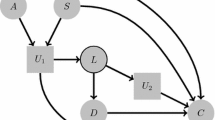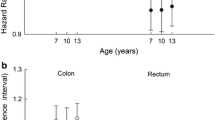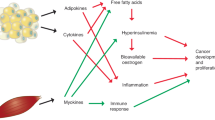Abstract
Purpose
We examined colon cancer risk in atomic bomb survivors to investigate whether excess body weight after the bombings alters sensitivity to radiation effects.
Methods
Of the 56,064 Japanese atomic bomb survivors with follow-up through 2002 with self-reported anthropometric data obtained from periodic mail surveys, 1,142 were diagnosed with colon cancer. We evaluated the influence of body mass index (BMI) and height on radiation-associated colon cancer risk using Poisson regression.
Results
We observed a similar linear dose–response relationship for the 56,064 subjects included in our analysis and the entire cohort of Japanese atomic bomb survivors [excess relative risk (ERR) per Gray (Gy) = 0.53, 95 % confidence interval (CI) 0.25–0.86]. Elevation in earliest reported BMI, BMI reported closest to colon cancer diagnosis, and time-varying BMI were associated with an elevated risk of colon cancer [relative risk (RR) per 5 kg/m2 increase in BMI = 1.14, 95 % CI 1.03–1.26; RR = 1.16, 95 % CI 1.05–1.27; and RR = 1.15, 95 % CI 1.04–1.27, respectively]. Height was not significantly related to colon cancer risk. Inclusion of anthropometric variables in models had little impact on radiation risk estimates, and there was no evidence that sensitivity to the effect of radiation on colon cancer risk depended on BMI.
Conclusions
Radiation exposure and BMI are both risk factors for colon cancer. BMI at various times after exposure to the atomic bombings does not significantly influence the relationship between radiation dose and colon cancer risk, suggesting that BMI and radiation impact colon cancer risk independently of each other.
Similar content being viewed by others
Explore related subjects
Discover the latest articles and news from researchers in related subjects, suggested using machine learning.References
Preston DL, Ron E, Tokuoka S, Funamoto S, Nishi N, Soda M, Mabuchi K, Kodama K (2007) Solid cancer incidence in atomic bomb survivors: 1958–1998. Radiat Res 168(1):1–64. doi:10.1667/RR0763.1
Harriss DJ, Atkinson G, George K, Cable NT, Reilly T, Haboubi N, Zwahlen M, Egger M, Renehan AG (2009) Lifestyle factors and colorectal cancer risk (1): systematic review and meta-analysis of associations with body mass index. Colorectal Dis 11(6):547–563. doi:10.1111/j.1463-1318.2009.01766.x
Ning Y, Wang L, Giovannucci EL (2010) A quantitative analysis of body mass index and colorectal cancer: findings from 56 observational studies. Obes Rev 11(1):19–30. doi:10.1111/j.1467-789X.2009.00613.x
Kono S (2004) Secular trend of colon cancer incidence and mortality in relation to fat and meat intake in Japan. Eur J Cancer Prev 13(2):127–132
Yiu HY, Whittemore AS, Shibata A (2004) Increasing colorectal cancer incidence rates in Japan. Int J Cancer 109(5):777–781. doi:10.1002/ijc.20030
Nakashima E, Fujiwara S, Funamoto S (2002) Effect of radiation dose on the height of atomic bomb survivors: a longitudinal study. Radiat Res 158(3):346–351
Otake M, Fujikoshi Y, Funamoto S, Schull WJ (1994) Evidence of radiation-induced reduction of height and body weight from repeated measurements of adults exposed in childhood to the atomic bombs. Radiat Res 140(1):112–122
Nikjoo H, Lindborg L (2010) RBE of low energy electrons and photons. Phys Med Biol 55(10):R65–R109. doi:10.1088/0031-9155/55/10/R01
Brenner DJ, Hall EJ (2007) Computed tomography—an increasing source of radiation exposure. N Engl J Med 357(22):2277–2284. doi:10.1056/NEJMra072149
Chang ML, Hou JK (2011) Cancer risk related to gastrointestinal diagnostic radiation exposure. Curr Gastroenterol Rep 13(5):449–457. doi:10.1007/s11894-011-0214-8
Shamseddeen H, Getty JZ, Hamdallah IN, Ali MR (2011) Epidemiology and economic impact of obesity and type 2 diabetes. Surg Clin North Am 91(6):1163–1172. doi:10.1016/j.suc.2011.08.001
Center MM, Jemal A, Ward E (2009) International trends in colorectal cancer incidence rates. Cancer Epidemiol Biomarkers Prev 18(6):1688–1694. doi:10.1158/1055-9965.EPI-09-0090
Sauvaget C, Nagano J, Allen N, Grant EJ, Beral V (2003) Intake of animal products and stroke mortality in the Hiroshima/Nagasaki Life Span Study. Int J Epidemiol 32(4):536–543
Pierce D, Stram D, Vaeth M (1990) Allowing for random errors in radiation dose estimates for the atomic bomb survivor data. Radiat Res 123(3):275–284
Sposto R, Preston D (1992) Correcting for catchment area nonresidency in studies based on tumor registry data. Radiation Effects Research Foundation, Hiroshima
Physical status: the use and interpretation of anthropometry. Report of a WHO Expert Consultation. WHO Technical Report Series No. 854. (1995). World Health Organization, Geneva
Renehan AG, Tyson M, Egger M, Heller RF, Zwahlen M (2008) Body-mass index and incidence of cancer: a systematic review and meta-analysis of prospective observational studies. Lancet 371(9612):569–578. doi:10.1016/S0140-6736(08)60269-X
Calle EE, Miracle-McMahill HL, Thun MJ, Heath CW Jr (1995) Estrogen replacement therapy and risk of fatal colon cancer in a prospective cohort of postmenopausal women. J Natl Cancer Inst 87(7):517–523
Hogan AM, Collins D, Baird AW, Winter DC (2009) Estrogen and gastrointestinal malignancy. Mol Cell Endocrinol 307(1–2):19–24. doi:10.1016/j.mce.2009.03.016
Rossouw JE, Anderson GL, Prentice RL, LaCroix AZ, Kooperberg C, Stefanick ML, Jackson RD, Beresford SA, Howard BV, Johnson KC, Kotchen JM, Ockene J (2002) Risks and benefits of estrogen plus progestin in healthy postmenopausal women: principal results From the Women’s Health Initiative randomized controlled trial. JAMA 288(3):321–333. doi:10.1001/jama.288.3.321
Simpson ER (2003) Sources of estrogen and their importance. J Steroid Biochem Mol Biol 86(3–5):225–230. doi:10.1016/S0960-0760(03)00360-1
Grant EJ, Neriishi K, Cologne J, Eguchi H, Hayashi T, Geyer S, Izumi S, Nishi N, Land C, Stevens RG, Sharp GB, Nakachi K (2011) Associations of ionizing radiation and breast cancer-related serum hormone and growth factor levels in cancer-free female A-bomb survivors. Radiat Res 176(5):678–687. doi:10.1667/RR2631.1
Bostick R, Potter J, Kushi L, Sellers T, Steinmetz K, McKenzie D, Gapstur S, Folsom A (1994) Sugar, meat, and fat intake, and non-dietary risk factors for colon cancer incidence in Iowa women (United States). Cancer Causes Control 5(1):38–52
Robsahm T, Tretli S (1999) Height, weight and gastrointestinal cancer: a follow-up study in Norway. Eur J Cancer Prev 8(2):105–113
Huxley R (2007) The role of lifestyle risk factors on mortality from colorectal cancer in populations of the Asia-Pacific region. Asian Pac J Cancer Prev 8(2):191–198
Sung J, Song YM, Lawlor DA, Smith GD, Ebrahim S (2009) Height and site-specific cancer risk: a cohort study of a Korean adult population. Am J Epidemiol 170(1):53–64. doi:10.1093/aje/kwp088
Cats A, Dullaart RP, Kleibeuker JH, Kuipers F, Sluiter WJ, Hardonk MJ, de Vries EG (1996) Increased epithelial cell proliferation in the colon of patients with acromegaly. Cancer Res 56(3):523–526
Albanes D, Winick M (1988) Are cell number and cell proliferation risk factors for cancer? J Natl Cancer Inst 80(10):772–774
Otani T, Iwasaki M, Inoue M (2005) Body mass index, body height, and subsequent risk of colorectal cancer in middle-aged and elderly Japanese men and women: Japan public health center-based prospective study. Cancer Causes Control 16(7):839–850. doi:10.1007/s10552-005-4573-z
Acknowledgments
The authors thank Kiyohiko Mabuchi for his thoughtful comments in the preparation of this manuscript. They are grateful for the contributions of the atomic bomb survivors who have contributed to this study. The Radiation Effects Research Foundation (RERF), Hiroshima and Nagasaki, Japan, is a private, non-profit foundation funded by the Japanese Ministry of Health, Labour and Welfare (MHLW) and the U.S. Department of Energy (DOE). EOS, KJK, EG, RWM, SD, and CIL received support through DOE award DE-HS0000031 to the U.S. National Academy of Sciences. The views of the authors do not necessarily reflect those of the two governments.
Conflict of interest
The authors declare that they have no conflict of interests.
Author information
Authors and Affiliations
Corresponding author
Rights and permissions
About this article
Cite this article
Semmens, E.O., Kopecky, K.J., Grant, E. et al. Relationship between anthropometric factors, radiation exposure, and colon cancer incidence in the Life Span Study cohort of atomic bomb survivors. Cancer Causes Control 24, 27–37 (2013). https://doi.org/10.1007/s10552-012-0086-8
Received:
Accepted:
Published:
Issue Date:
DOI: https://doi.org/10.1007/s10552-012-0086-8




